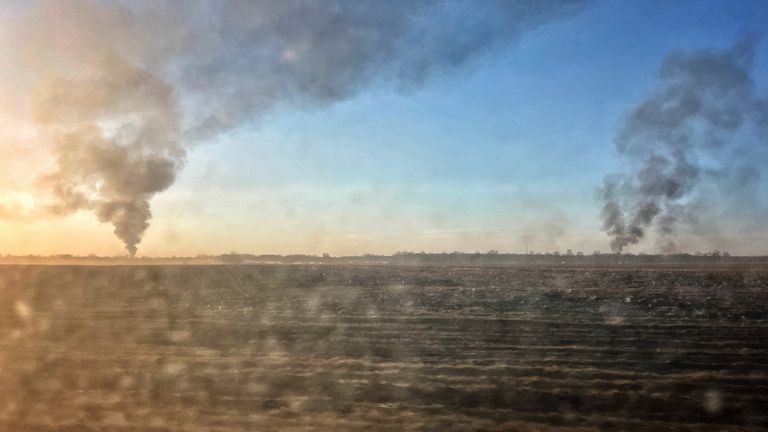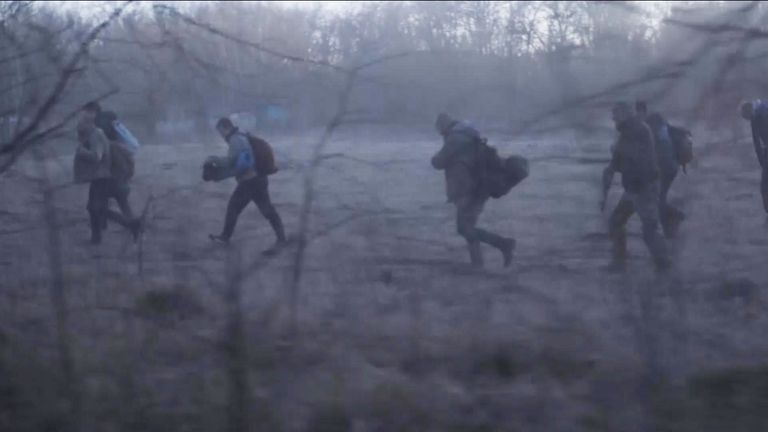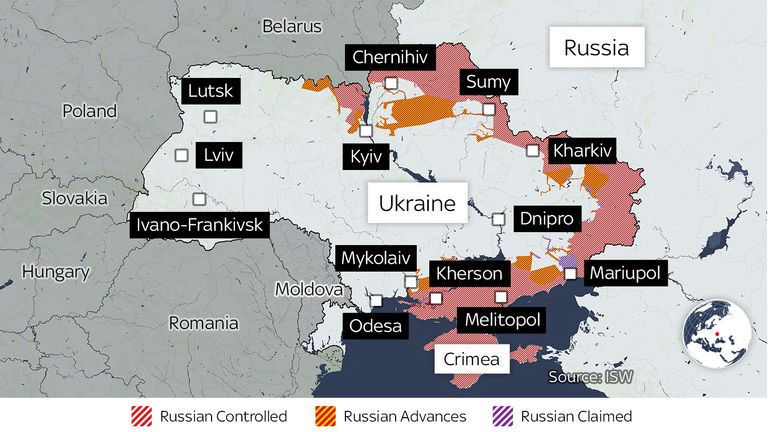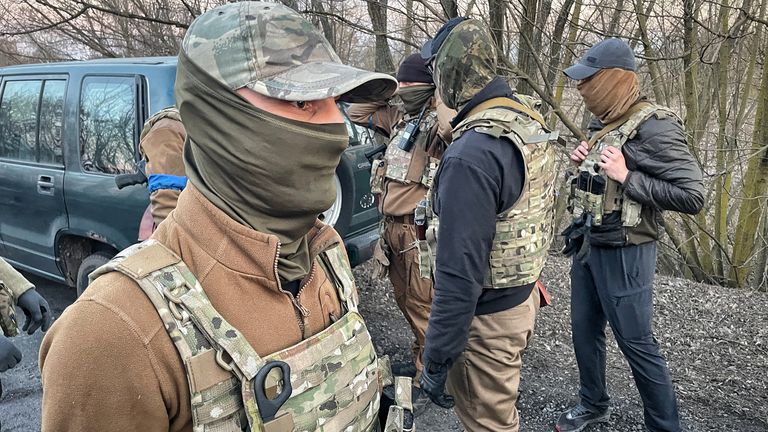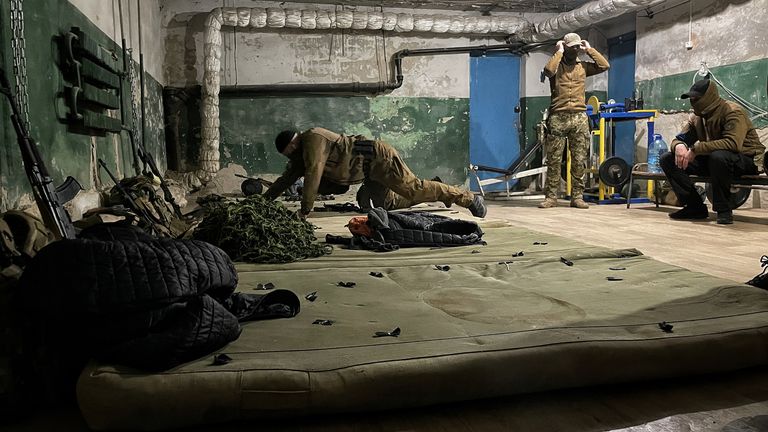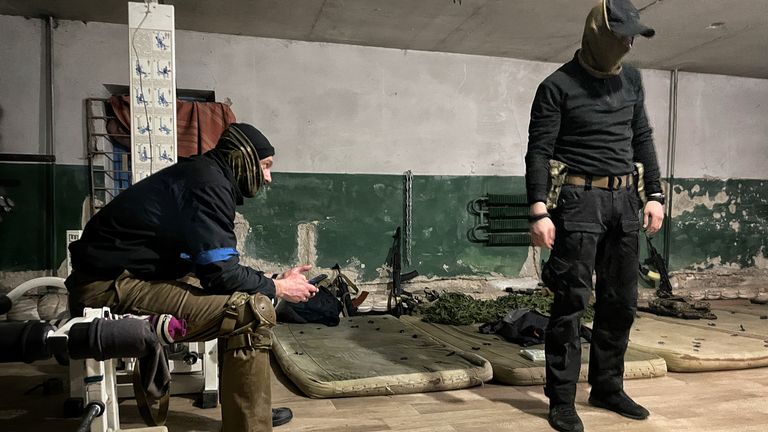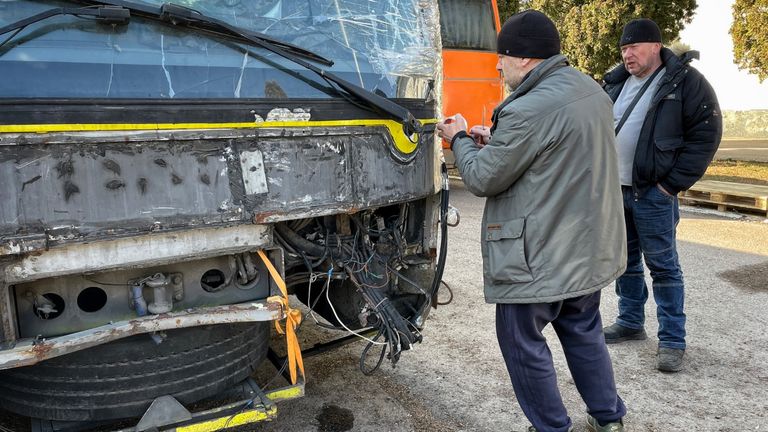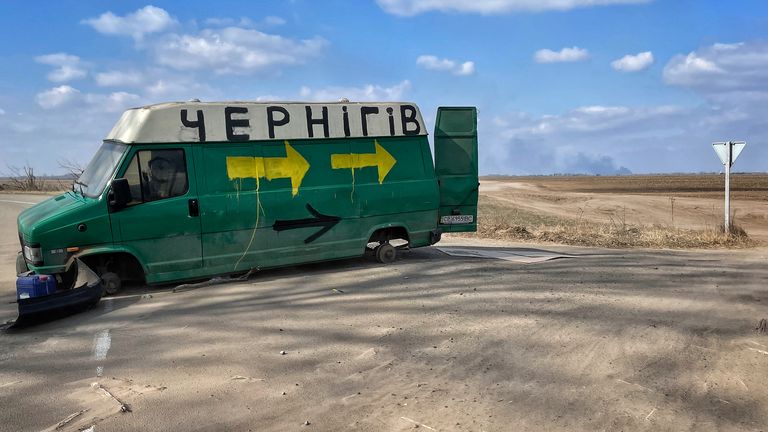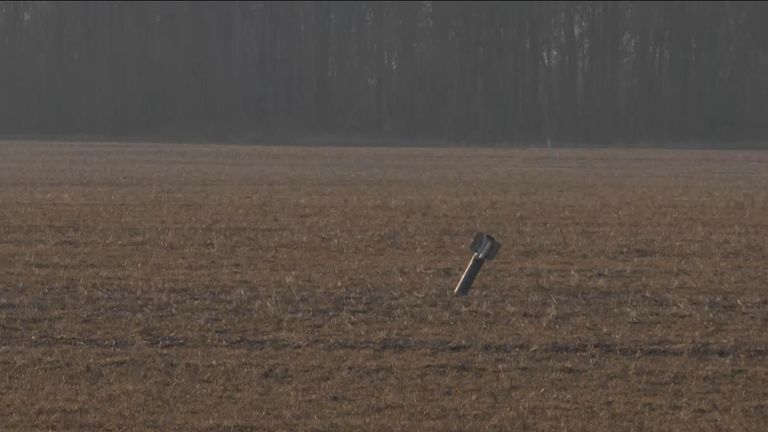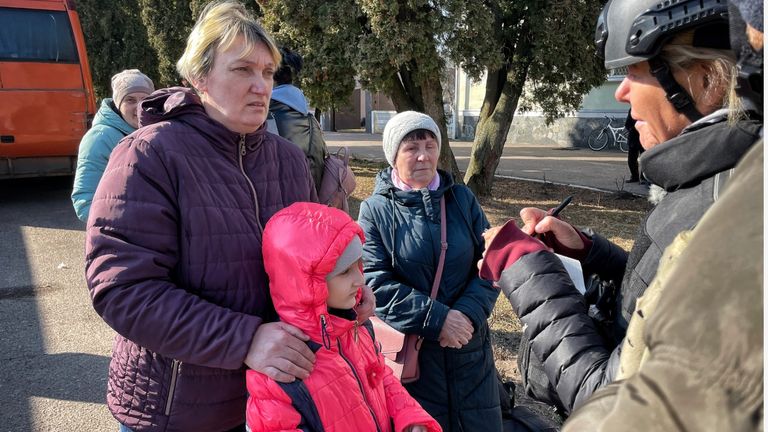Those who’ve made it out alive from the city of Chernihiv in north Ukraine call it “hell” – and fear it’s fast turning into another Mariupol by the advancing Russian troops.
We witnessed Chernihiv being brutally cut off – from all humanitarian aid and from the outside world.
The city has been bombarded for weeks now with Russian troops closing in and circling it. There have been so many airstrikes and so much artillery shelling that many who’ve escaped say they couldn’t come out of their underground shelters at all – day or night – for the past fortnight.
The city’s electricity has been cut. There’s little water, no heating and food is fast running out.
We saw the indiscriminate and terrifying Russian shelling of civilians, medics and rescue workers at the final crossing point over the River Desna where they’d gathered to flee to safety.
Volunteer soldiers and rescue workers were frantically trying to guide people over the last pedestrian bridge connecting Chernihiv to the main route leading to the capital Kyiv. By this stage, the Russian troops had closed in on three sides of the city and overnight had bombed the main transport bridge out.
A stream of vehicles, ambulances and emergency teams were racing over a dusty and boggy farmers’ field to get to the crossing. The humanitarian convoy taking aid in and hoping to bring civilians out was forced to drive across a huge open space where any vehicle movement was subject to attack.
The window on this narrow escape corridor to the southeast of the city was fast closing as we arrived with the convoy just before dusk.
We saw groups of civilians with their bags patiently waiting for the vehicles which could transport them out of this small, forested riverbank. There were lines of others, rucksacks on their backs being guided along the field and away from the river and the city.
Suddenly, a salvo of rockets came raining down on the area sending everyone crashing to the ground. Then mad panic ensued as dozens of vehicles hastily turned around and tried to weave their way through the trees and back out into the open field.
We saw the lines of civilians now spread-eagled on the ground, then quickly pick themselves up and walk with fresh urgency away from their homes and city. But the attacks didn’t stop.
The Russians had already hit the pedestrian bridge by now but as the civilians and emergency vehicles accelerated away, the strikes followed them.
Not content with destroying the one route out of the besieged city, the Russian military wanted to cause as much death and injury to those trying to run away too.
Chernihiv is strategically important because it stands slap-bang across the north route chosen by Russia for its advance on the capital. The city sits on the Desna River some 150km (93 miles) to the north, northeast of Kyiv.
The Russian troops have spent the past month trying to bulldoze their way through the ancient city which has monuments and churches that date back centuries.
But with no submission from the city or its people, the Russian military seems set on starving and bombing it into surrender.
Inside Chernihiv, the mayor has managed to film some of the destruction and there are bombed houses and buildings on fire everywhere. There are still an estimated 150,000 people trapped inside the city. “We cannot cope with all our dead,” the mayor says. “It’s carnage.”
Another of his officials tells us by phone: “They’re trying to create as big a humanitarian disaster as possible. They cannot beat us militarily so they’re trying to force us to give up this way.”
Those who can, make it to the nearby villages and communities just south of the city. But even here, the sounds of shelling and bombings go on through the night. Along with most of the village, we retreat with a group of voluntary soldiers into an old gym basement for the night.
The volunteer soldiers have asked for their identities to remain a secret. They take the opportunity to catch their breath and many ring home to talk to their families.
“My heart is just breaking,” says one, a paratrooper in the Ukrainian army for more than a decade but then retrained as a lawyer and took up arms again to fight for his country.
They’re all from Chernihiv. It’s a city they love and call home. Among them is a dentist, a PE teacher, a landscape gardener and an ex-convict, who says with a smile: ‘I’m a bandit. I was in prison before. Now I’m trying to save my country.”
Another who is organising humanitarian aid and evacuation convoys from the city tells us: “How can I explain the importance of human life. What could be more important than saving the lives of children, of little girls and boys. Nothing makes us do this. This is just what we have to do.”
Away from their own families, they’re saving the lives of others.
Next morning, we head back with them to the open field and towards the pedestrian bridge crossing point. But it’s clear Chernihiv has taken a pummelling overnight.
There are banks of vehicles and medics lined up in the nearest village hoping to get in or close by to help casualties or just provide transport for any civilians who manage to make it out. But there are none and any vehicle which tries to cross is being fired upon.
As we reach the beginning of the open field, a yellow van which has been turned into a mobile medical emergency vehicle and has big red crosses painted over its bonnet, pulls up in front of us. We can see the driver has black soot all over his face and in his nostrils.
He has a cut on his forehead and looked shaken. “I need help,” he says. He struggles out of his van and we can see his left trouser leg is soaked in blood. He’s limping.
“This is not so serious,” he says, motioning towards his leg. “I have another wound in my side. It’s serious. I can’t breathe.”
One of our team, producer Jake Jacobs, pulls out his medical kit to see if he can assist. The man, who says he’s Yuri Zebrovski and a former paramedic in the Ukrainian military, has shrapnel lodged in his leg.
He’s going to need surgery but Jake patches him up. He looks at his chest wound and more shrapnel seems to have punctured his lung. He’s going to need hospital treatment and more surgical help for that too.
He says he was parked near the bombed pedestrian bridge hoping to pick up any civilians who could make it across when the attack happened. “It was about 15 minutes ago,” he says.
“I saw destroyed cars….destroyed civilian cars,” he explains, “They were all burned out, completely destroyed and there was one dead civilian.”
Attacking civilians and all non-combatants including medics is a potential war crime. He limps back into his vehicle and says out of the window: “Our country needs your help. Good luck”, before giving us a peace sign and driving off.
In one of the farmers’ fields a few kilometres away, we find a spread of cluster bomb casings. We’ve consulted several independent experts including the investigative journalism group Bellingcat but also Human Rights Watch and Jane’s Defence.
Bellingcat’s founder Eliot Higgins is compiling a dossier charting the use of cluster bombs in Ukraine during this war.
He told Sky News: “Those are the remains of 220mm 9M27K cluster rockets used by the BM-27 Urugan multiple rocket launcher. It’s been used widely across Ukraine. Both sides do operate it but you can tell which direction they were fired from based on which way the ones stuck in the ground are pointing to.”
Based on the angle of the tail fins and the cluster munition containers, the cluster bombs appear to have been fired from the direction of the Russian frontlines around Chernihiv.
The cluster containers usually land in front of where the munitions have fallen, according to the experts putting the cluster bombs destination and landing areas as primarily over the ancient city.
Cluster munitions, says Bellingcat, deploy a large number of smaller sub-munitions over a target which then spread and explode over a large area increasing the potential for casualties.
They’re often criticised as weapons that pose an immediate threat to civilians during conflict and are considered especially dangerous because of the “long-lasting” problems if they do not explode on first impact.
Although more than a hundred countries have agreed to ban their use, neither Ukraine nor Russia are signatories to this treaty. However, both are bound by international humanitarian law which bans the use of indiscriminate attacks – and the United Nations has warned Russia against using them.
UN spokesperson Liz Throssell told journalists in Geneva recently: “We remind the Russian authorities that directing attacks against civilians and civilian objects, as well as so-called area bombardment in towns and villages and other forms of indiscriminate attacks, are prohibited under international law and may amount to war crimes.”
Those who’ve made it out of Chernihiv told us of the nightmarish existence inside. “It’s hell there. It’s hell,” said Tatiana Chaban, weeping.
“My children’s godmother is still there. They spend days and night in the shelters underground. It’s too unsafe to come out. They have no food, no gas, no electricity. It’s just like Mariupol with bombing all the time. Everyone is cut off. It’s terrible.”
There’s now increased urgency to try to reach some sort of agreement for a humanitarian corridor to allow the rescue of those still trapped.
But few expect there to be an agreement soon – and there’s a great deal of suspicion about whether it will be respected. The hell for those in Chernihiv is a hell which doesn’t look like ending soon.
And beyond Chernihiv is the capital, Kyiv.
Alex Crawford is reporting from outside Chernihiv with camera operator Jake Britton and producers Chris Cunningham, Oleksandre Piskun and Mihailo Vadimovich Cherniak.


